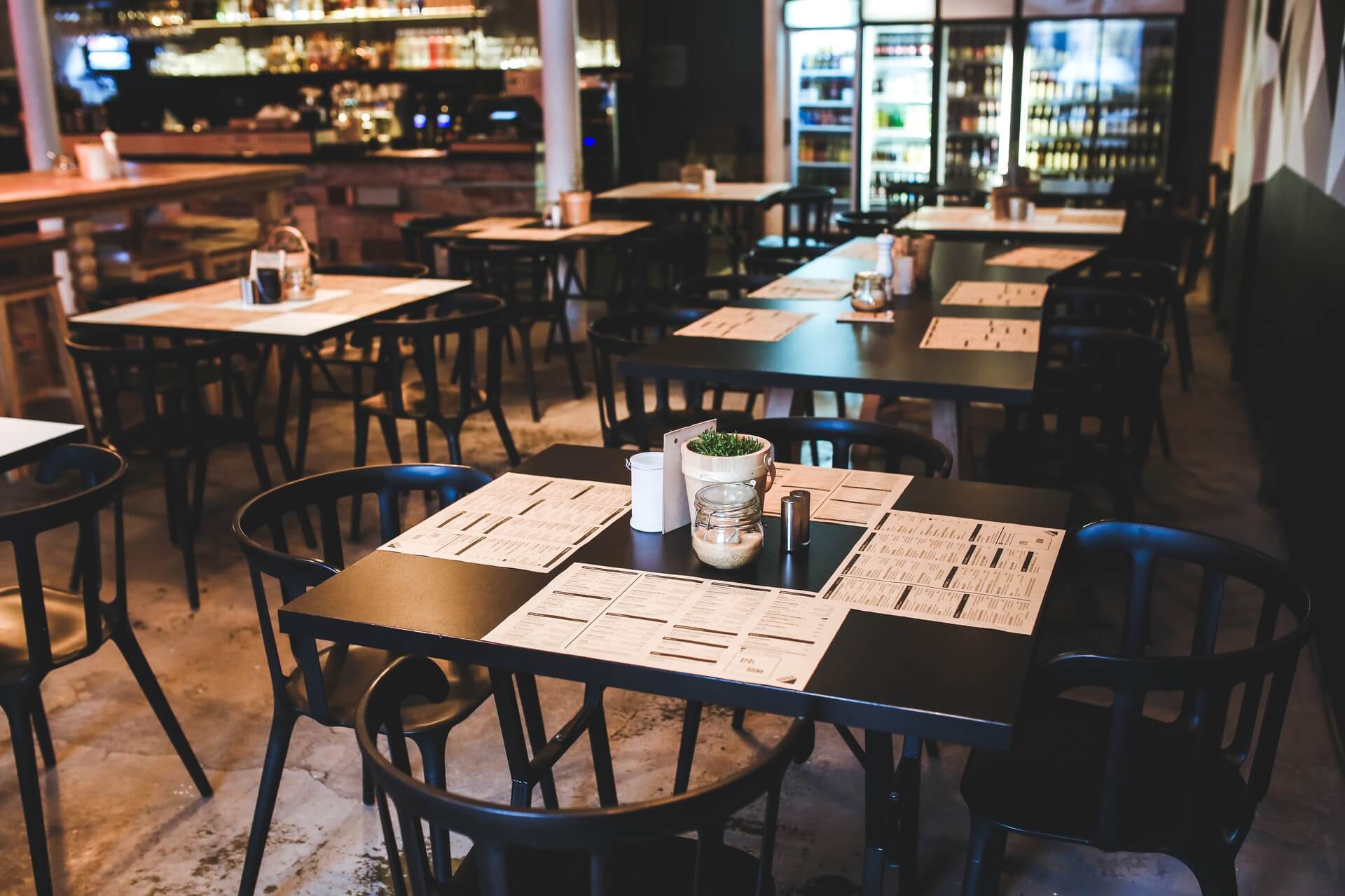

Researching and analyzing thousands of menu cards from thousands of restaurant locations in a given geographical area is a daunting task. The process is long and can be tedious, involving multiple steps.
You drive over to a competitor’s restaurant and photograph the menu, drive back, manually enter the contents and structure of the menu into a spreadsheet, construct a usable database, and finally, use the data to your advantage. Do this a hundred or thousand times over and you will have a valuable amount of data.
The man hours it costs to do this and the amount of time it will take before you have a solid amount of data is inefficient and certainly not cost-effective. Well, what if you take a different approach? We live in a modern age, there must be a way of having a computer do all the work for us, right?
You would be right! In this blog, we will explain how you can automate the process of menu card scanning using Optical Character Recognition (OCR) and Machine Learning.
What is Menu Card OCR?
Menu card OCR refers to the technology and process of scanning menu cards and extracting data, further converting it into a searchable format.
This is done through the following steps:
- You upload a photo of a menu card to the API.
- The API scans the photo and clarifies its content with blur and glare detection and correction.
- The image is then read with the help of OCR, and extracted into a raw TEXT file.
- This TXT file is converted into a JSON format, which allows the data to be contextualized and categorized.
- You receive the JSON output, which can be deployed in data management software and is easily and automatically transferred into research plans.
The JSON output is automatically structured into predetermined data presets, which allows you to contextualize all data on the menu card. This means you don’t have to place every item into the context slot on a spreadsheet yourself.
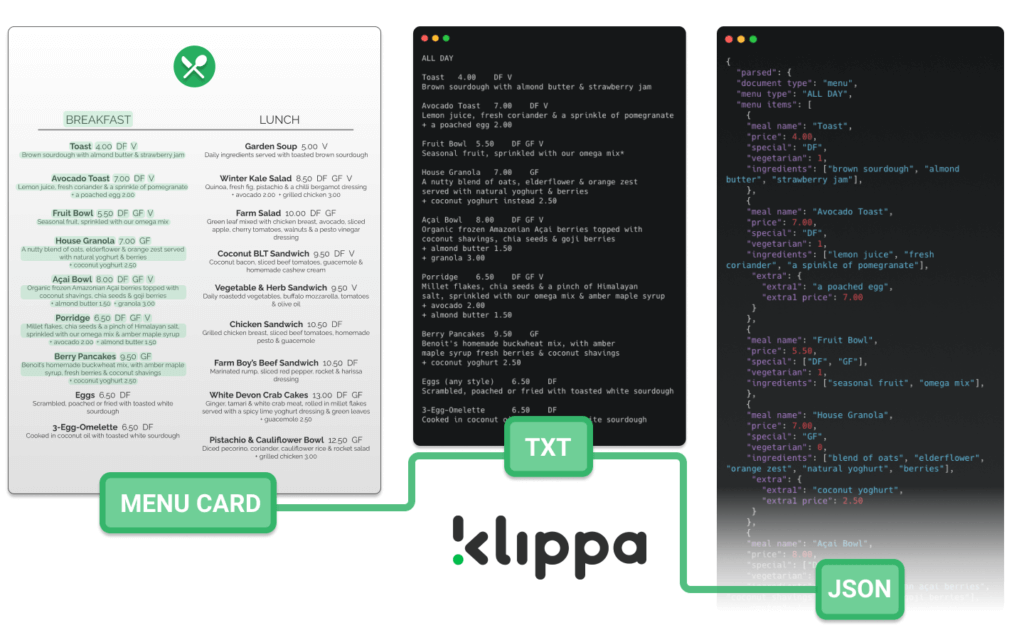

How was Menu Data Extraction Performed Before OCR?
Before the advent of OCR technology for menu data extraction, the process involved a more hands-on approach and a series of manual inefficient steps. Good market research is crucial because it provides you with a continuous and current understanding of your competitors’ actions.
By staying informed about their pricing strategies and the introduction of new menu items, among other pertinent details, you gain valuable insights that can significantly enhance your competitive edge.
Gathering data on competitors or other restaurants in your neighborhood before automation would involve a series of manual and inefficient steps.
- Take a photo of a restaurant menu card. This photo can be taken in haste or subject to low lighting.
- Data on the photo is manually transferred into a spreadsheet, including sections such as name, course, ingredients, price, allergy warnings, and more. This information is combined with the name and address of the restaurant.
- The spreadsheet is then processed by hand into a database of multiple restaurants.
- This database is scoured for useful information on which conclusions about for example pricing can be made.
Essentially, if you wish to keep ahead of the competition, you would need to do this regularly. This means this painstaking process starts over every month, or sometimes even every week, which makes it a costly and time-consuming endeavor. This type of high volume and frequency work will expand your crew requirements, which might tempt you to look at back-office outsourcing to low-wage countries. Understandable, but maybe there is another way.
How Does Menu Card OCR Work?
Menu card OCR automates the process of extracting and organizing information from menu cards, making it accurate, fast, and efficient. Here’s how it works step by step:
- Take or Upload a Picture/PDF:
An easy-to-use GUI (Graphical User Interface) gives you access to the camera within the app, allowing you to take and upload a picture or upload a PDF. The app automatically improves the image by fixing the perspective and detecting blur or glare. - The API Connects the Pieces:
Once uploaded, the API (a service that connects the app’s front-end and back-end) sends the document to a trained system that processes the content. - Extracting Text with OCR:
The system uses Optical Character Recognition (OCR) to identify and extract readable text from the image. This text is converted into a digital format (like a simple text file). - AI Understands the Content:
A smart neural network (AI) analyzes the text and its context. For example, it can identify sections and prices on a menu, organizing the information logically instead of just turning it into plain text. - Output in a Useful Format:
The processed data is transformed into a JSON file. JSON organizes the information, making it easy to link data points and use them for research or database purposes.
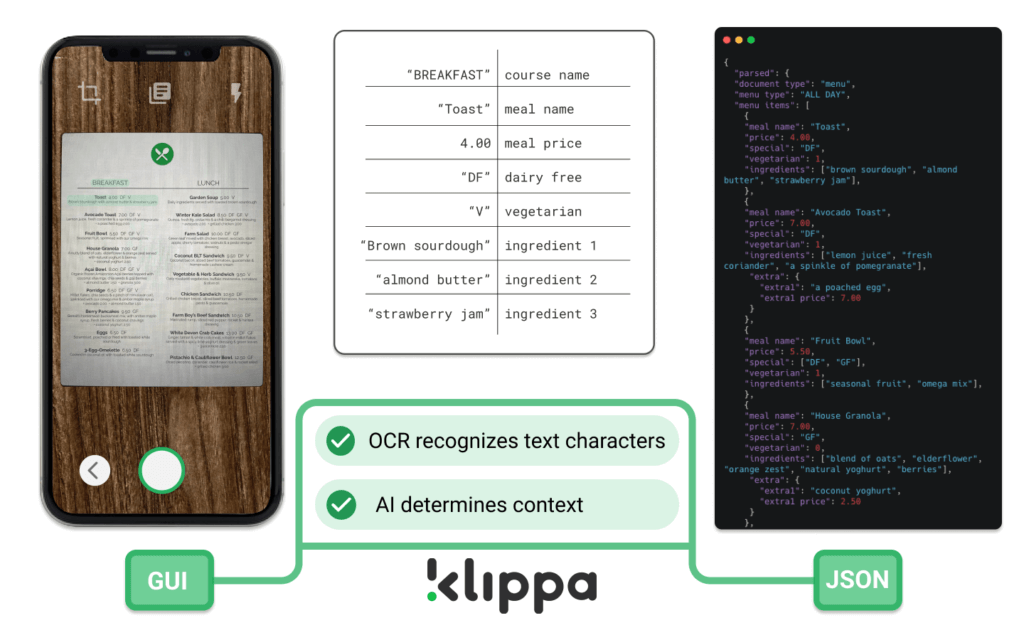

This fully automated process reduces the need for manual data entry, ensuring accuracy and speed. With practical training and ongoing learning, the AI delivers results tailored to your needs.
What Can You Use Menu Card OCR for?
Menu card OCR offers a range of practical applications, leveraging its ability to convert the content of a menu card into digital text. With this technology, you can enhance customer experiences, optimize business operations, and develop data-driven insights within the food and hospitality industry.
The result is data that you can use for your own specific aims. It is perfect for the following purposes:
Market research
Quickly contextualize what restaurants and bars from your specific target group are offering and at which price, but also how that might change over time. It can be for exploratory, descriptive, or casual purposes and has the goal of determining a business strategy, competitiveness,s or simply for research purposes.
Competitor analysis style
With an accurate overview of menu offerings, pricing, and changes of your direct competitors, you can quickly adapt and be one step ahead of the competition at all times. This empowers businesses to stay agile by promptly adapting their selection based on up-to-date insights gleaned from competitor menus.
Geographical pricing analysis
By singling out a specific area or region, you can use the data to set up research into pricing trends of restaurants and bars in the vicinity. You can adapt your own pricing scheme with accurate, contextual data. With a data-driven approach, businesses are empowered to conduct in-depth research and adjust their pricing strategies based on accurate and contextual information, aligning their offer with local market dynamics.
Large-scale menu digitization
This process is fully automatic, accurate, fast, and most of all modern. The API is supported by an AI that has been trained with practical examples and continues to learn over time. It allows you to keep everything within your own control, without being dependent upon error-prone manual entry.
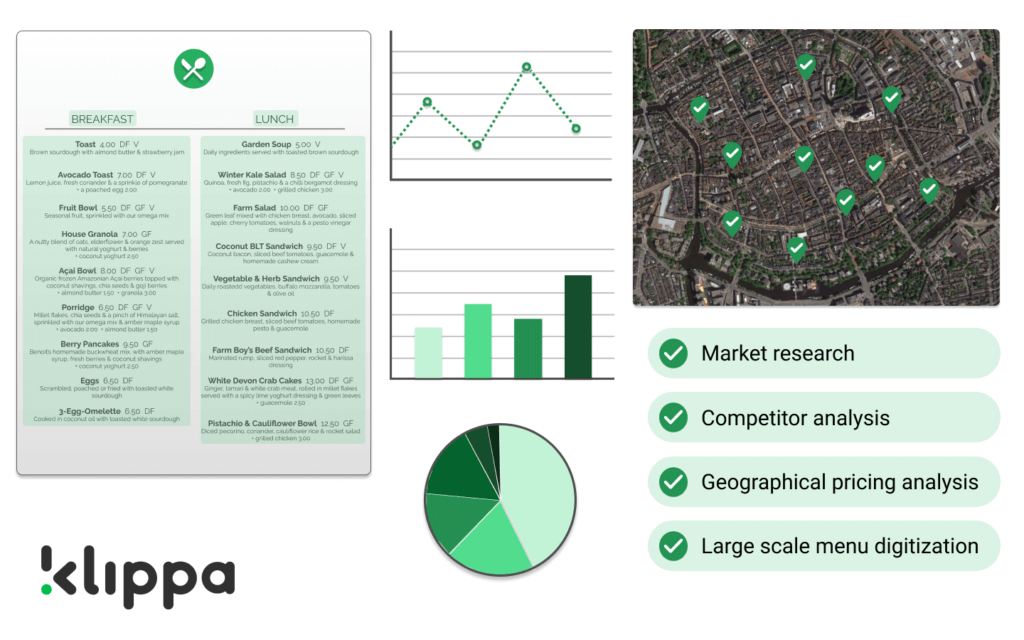

Real-World Examples of Menu Card OCR
So who exactly benefits from menu card OCR? Although you’ll find that the possibilities of using this data are near endless, we’ll provide you with three use cases:
Restaurant Owners
Large restaurant chains need to keep track of what competitors in the area are doing. This is especially true when you drive a format that is meant to be competitive and consequently has many adversaries in a local area.
Whether you are challenging the market in terms of pricing, originality of menu, variety or any other format that involves what is on the menu card, a constant eye on what the competition is doing is paramount. It will give you a competitive advantage over the rest.
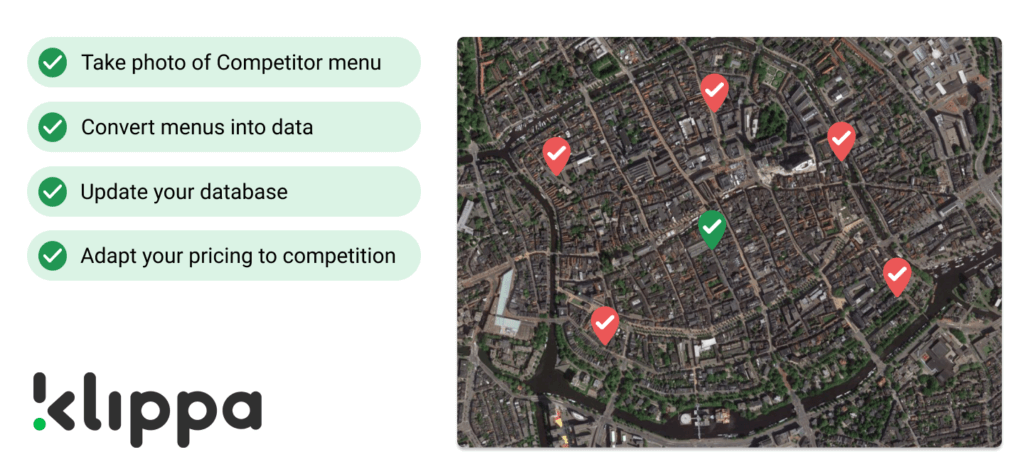

The best way is to plan a monthly photo of relevant competitor menu cards in the vicinity. If you immediately take the photo in the app, you can instantly upload the image and it is processed directly. Say you wish to process a thousand menu cards per month in a large urban area and you need to quickly access the data.
Every time an employee uploads a picture, it is converted into JSON data within seconds. Your database can thus be kept up to date at any time. This means you can for instance safely boast the cheapest menu in the area or country, for you will know it to be true.
Food Delivery Platforms
Especially in times of COVID-19, the predominance of delivery platforms has grown. If you wish to compete in this sometimes saturated market, it is clear that you need an easy way of onboarding. However, it is just as important to keep your platform up to date.
To compete, you need to offer the delivery of hundreds of restaurants and bars, all of which adapt their menus with increasing regularity. You would need a fast way of processing all restaurant menus so that none of the information on your platform is outdated.
A quick way is to have participating restaurants upload a photo of each new menu card to our API. With menu card OCR each menu is scanned and read, extracting all relevant data into a JSON format. This format allows you to swiftly and automatically update any restaurant menu listing on your delivery platform. It is an excellent way to keep both participating restaurants and of course your customers happy.
Market Research Agency
If you aim to serve the restaurant industry with accurate data, you need to instigate an effective way of gathering that data. Whether it concerns a simple SWOT analysis or menu optimization for a restaurant, you should be able to offer your clients accurate and swift advice based on a thorough investigation.
Of course, you have employees who should be able to manually gather data, or you have chosen to outsource this back office work to low-wage countries. Still, gathering data is more of a computer’s job, wouldn’t you say?
Using an API to take over this work results in a more cost-efficient, more accurate, and faster process. Transforming a menu card into usable, segmented data is done by menu card OCR within a matter of seconds, whereas an employee will take longer to enter the data into segmented spreadsheets.
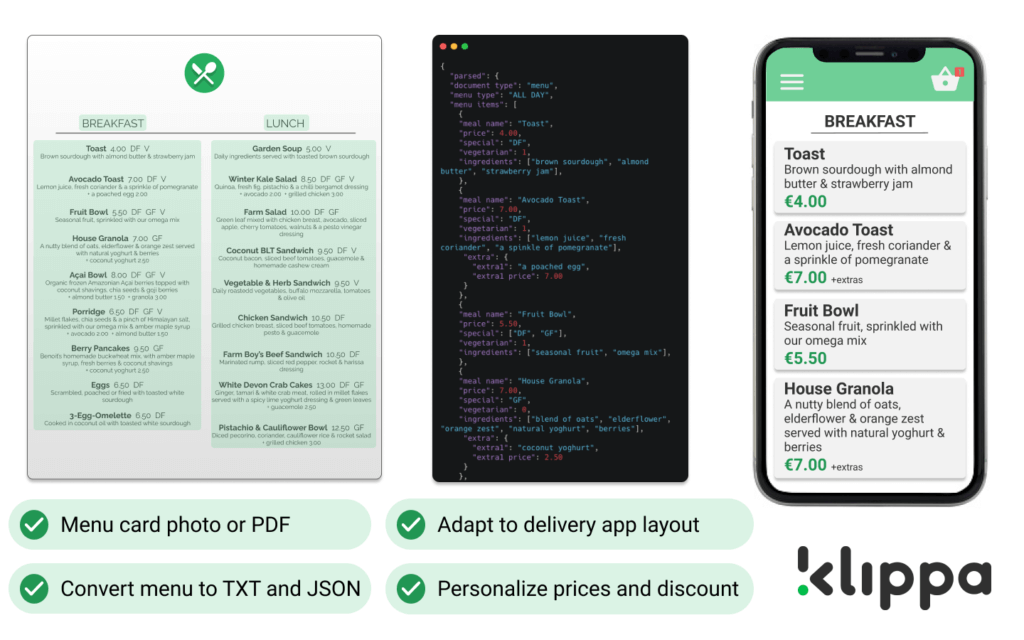

Potential Challenges of OCR for Menu Cards
While Optical Character Recognition (OCR) technology offers significant advantages in automating menu data extraction, it is not without its challenges. Below are some common limitations businesses may face when using OCR for menu cards, along with practical solutions to overcome them.
1. Handwritten or Stylized Fonts
Many restaurant menus feature handwritten elements, artistic calligraphy, or stylized fonts that can be difficult for OCR engines to recognize accurately. This can lead to errors in text extraction.
To address this, businesses can implement AI-powered OCR, also called Intelligent Character Recognition (ICR), a more advanced OCR technology that is specifically designed to handle handwritten text. Additionally, training OCR models with machine learning on a variety of stylized fonts and applying contrast adjustments can improve accuracy significantly.
2. Poor Image Quality and Low-Resolution Scans
OCR accuracy heavily depends on image quality. Blurry images, low-resolution scans, and poor lighting conditions can significantly reduce the effectiveness of text extraction.
The best way to counter this is by using high-resolution cameras or scanners with autofocus capabilities. Pre-processing techniques like image sharpening, contrast enhancement, and noise reduction can also help clarify text for better recognition.
3. Menu Layout Complexity and Variability
Unlike structured documents, menus often have complex layouts with multiple columns, sections, and varying font sizes. This makes it difficult for OCR to determine the correct reading order and category of extracted text.
To solve this, businesses can use Zonal OCR, a technique that targets specific areas of a document for structured data extraction. Pairing OCR with Natural Language Processing (NLP) can further refine results by identifying food-related keywords and properly categorizing menu items.
4. Language and Multilingual Menus
Many restaurants offer menus in multiple languages, including special characters, accents, or symbols that standard OCR models may not accurately interpret.
To improve results, businesses should opt for multilingual OCR engines that support a wide range of languages. Additionally, NLP-based language detection can help correct extracted text and provide dictionary-backed error correction, ensuring accuracy across multiple languages.
5. Mislabeled or Inaccurate Data Extraction
OCR may extract text but misclassify it due to missing contextual understanding. For example, it may misinterpret item names as descriptions or mix up prices.
Machine learning-based OCR models trained on extensive menu datasets can significantly enhance contextual accuracy. Combining this with entity recognition systems helps classify extracted data more effectively. In high-stakes scenarios, adding a human verification step ensures that crucial menu data remains error-free before being processed further.
Achieving high accuracy and efficiency in menu data extraction requires the right technology partner. This is where Klippa DocHorizon comes in. By leveraging AI-driven OCR, machine learning, and intelligent data processing, Klippa ensures seamless and highly accurate menu card digitization.
Automate Menu Card Data Extraction with Klippa
Klippa DocHorizon is an ISO-certified and GDPR-compliant platform, enabling you to automate menu data extraction securely and reliably. With our solution, you can:
- Design Custom Menu Workflows: Fully control how you manage your menu data. Define input and output sources, and seamlessly integrate our software with your existing systems (50+ out-of-the-box integrations).
- Achieve Up to 99% Data Extraction Accuracy: Automatically extract all relevant menu data, such as item names, categories, and prices, without relying on manual input. Get accurate and actionable data for better decision-making.
- Enhance Data Management: Automation ensures that menu data is well-organized, making it simple to search, retrieve, and analyze.
- Expand Global Reach: Process menus from restaurants and partners worldwide, as Klippa DocHorizon supports 100+ languages and multiple menu formats.
- Scale with Ease: Klippa’s bulk processing capabilities allow you to handle large volumes of menu data efficiently, ensuring you’re ready to grow your business without additional strain.
Automating menu data extraction has never been easier with Klippa DocHorizon! Focus your time and resources on what matters most, and eliminate inefficient manual processes. Contact our experts for more details or book a free demo below!
Frequently Asked Questions
Given that nearly all menu cards follow a similar format, our OCR API can distinguish all information on a menu card and transfer it into a JSON format. You can think of the division into aperitif, main course, dessert, and so on, but also vegetarian or vegan and pricing schemes.
Does menu OCR work with low-quality photos?
Especially when you quickly have to snap a photo of a menu card in all haste when passing a competitor restaurant, the quality of the photo will be compromised. Thankfully, our API includes image pre-processing capabilities that will improve and rotate bad-quality images for better processing.
In addition, Klippa offers a scanning SDK that can be implemented in mobile apps. This SDK includes image processing capabilities like perspective correction and glare and blur detection to clarify the content of photos. This way, you will only receive photos that contain valid information for further processing.
Which languages can Klippa process?
Currently, Klippa supports all Latin languages. Our engine performs best on price tags in English, Dutch, Norwegian, Danish, Swedish, Finnish, Italian, Portuguese, Spanish, German, and French.
However, other languages can be supported on request. We’re open to training our Machine Learning models. If you have a specific case, don’t hesitate to contact us.
How does Klippa ensure the security and privacy of data?
Klippa is committed to maintaining the highest standards of data security and privacy. We are ISO 27001 and ISO 9001 certified, demonstrating our adherence to international information security and quality management standards. Our solutions are designed to comply with global data protection regulations, including GDPR and CCPA, ensuring that all data is handled with the utmost care and confidentiality. Regular third-party penetration testing is conducted to validate the robustness of our security measures.
For more detailed information on our compliance and security practices, please visit our compliance page.